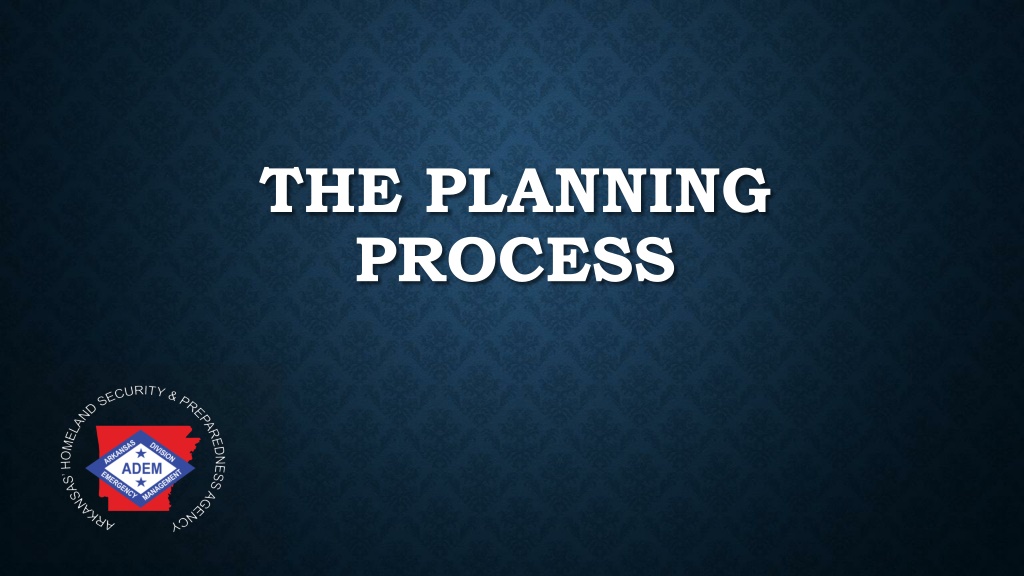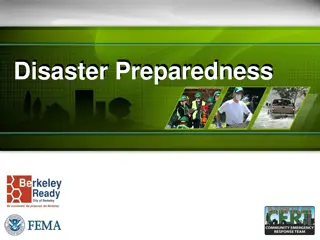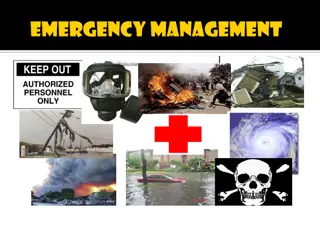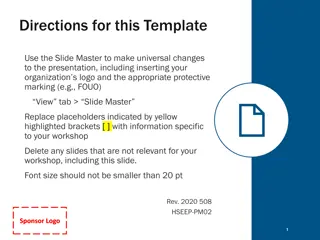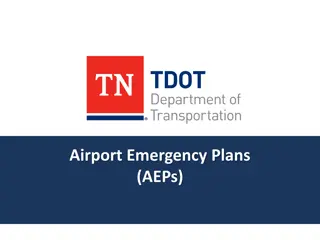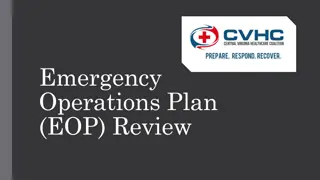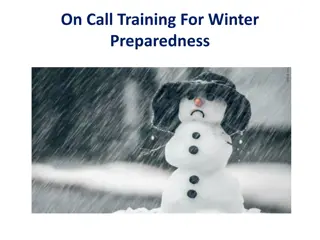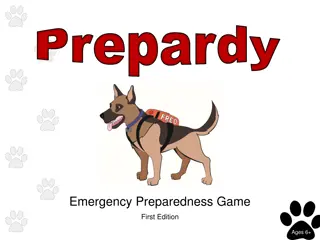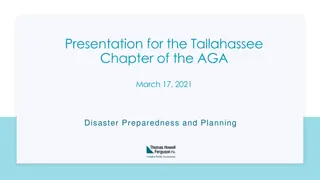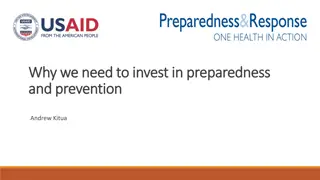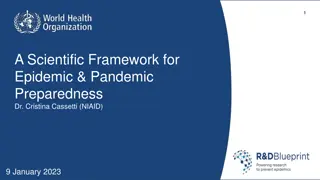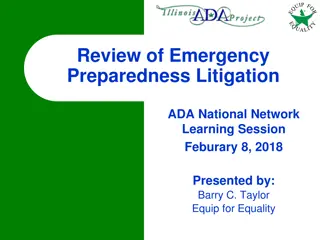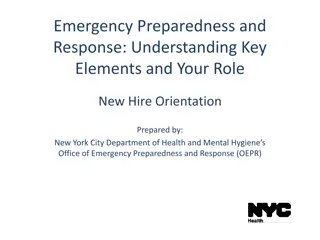Comprehensive Planning Process for Annual Preparedness Activities
Engage in a structured planning process involving workshops, reviews of existing plans, and annual tasks to enhance preparedness. Follow a detailed timeline leading up to the exercise, including concept and objective meetings, initial and midterm planning sessions, and drafting essential documentation.
Download Presentation

Please find below an Image/Link to download the presentation.
The content on the website is provided AS IS for your information and personal use only. It may not be sold, licensed, or shared on other websites without obtaining consent from the author. Download presentation by click this link. If you encounter any issues during the download, it is possible that the publisher has removed the file from their server.
E N D
Presentation Transcript
THE PLANNING PROCESS
THE PLANNING PROCESS (ANNUAL TASKS) Conduct a local Integrated Preparedness Planning workshop (IPPW) Involve local appointed and elected officials Review existing plans, policies, and procedures Review past After Action Reports (AARs)/Improvement Plan Matrix Review past identified training deficient areas
THE PLANNING TIMELINE Concept & Objective (C&O): 5-7 months before the exercise Initial Planning Meeting (IPM): 5-7 months before the exercise Midterm Planning Meeting (MPM): 3 months before the exercise Final Planning Meeting (FPM): 4-6 weeks before the exercise Print all exercise documentation: week of the exercise
CONCEPT & OBJECTIVE MEETING Identify the plan you want to test Choose the parts of the plan to test in your exercise Identify who should be part of your planning team based on what you are testing Decide when to meet for the IPM and all future planning meetings if possible
INITIAL PLANNING MEETING Draft S.M.A.R.T. Objectives Choose the core capabilities that aligns with each objective Select the appropriate mission area Identify the location, scope, and type of exercise Identify exercise participants
INITIAL PLANNING MEETING Identify needed exercise documentation Set a schedule for a draft of the identified documentation Outline evaluation requirements Begin to draft a scenario Assign tasks to the planning team members with due dates
MIDTERM PLANNING MEETING Review the drafted exercise documentation Build the scenario timeline Assign the Exercise Plan, Situation Manual, Facilitator's Guide, or Controller/Evaluator Handbook as needed Review the drafted EEGs to make sure they align with the tested objective
MIDTERM PLANNING MEETING Begin drafting the Master Scenario Events List (MSEL) & the Participant Feedback Form Send an exercise invitation to the identified exercise participants after the meeting Fill out a Exercise Notification Form and submit it to ADEM Exercise after the meeting
FINAL PLANNING MEETING Review and finalize the scenario timeline Review and finalize the exercise documentation Confirm the exercise date, time, & location with planning team
S.M.A.R.T OBJECTIVES
S.M.A.R.T OBJECTIVES S.M.A.R.T is an acronym used to identify the characteristics of good objectives They identify who should do what, under what conditions, and according to which standards 5-7 months before the exercise
S.M.A.R.T OBJECTIVES S.M.A.R.T Objectives are: Specific Measurable Achievable Relevant Time-bound 5-7 months before the exercise
S.M.A.R.T OBJECTIVES Specific: The objective specifies what needs to be done with a timeline for completion Objectives should address the five W s: Who? What? When? Where? Why? 5-7 months before the exercise
S.M.A.R.T OBJECTIVES Measurable: Objectives should include a numeric or descriptive measure that define: Quantity Quality Cost Focused on observable actions or outcomes 5-7 months before the exercise
S.M.A.R.T OBJECTIVES Achievable: Objective should be within the control, influence, and resources of exercise play and participant actions Objectives should be realistic goals or tasks based on your local plans, policies, procedures, etc. and your jurisdictional capabilities 5-7 months before the exercise
S.M.A.R.T OBJECTIVES Relevant: Objectives should be instrumental to the mission of the organization and link to its goals or strategic intent Objectives should be written based on local plans, policies, procedures, etc. 5-7 months before the exercise
S.M.A.R.T OBJECTIVES Time-Bound: A specified and reasonable timeframe should be incorporated into all objectives Example: In a drill, tabletop, functional, or full-scale exercise: within the first hour or within the first operational period For workshops: during the workshop 5-7 months before the exercise
HOW TO WRITE A S.M.A.R.T OBJECTIVE Consider the following objective: Republic City OEM will test our ability to establish emergency sheltering, food, and hydration support, for up to 25% of the people, at the county fair grounds, within the first 72 hours following the onset of the event. We will utilize our existing mass care plans and reach out to our partners to provide these services throughout the response to the event. 5-7 months before the exercise
HOW TO WRITE A S.M.A.R.T OBJECTIVE Answer the following questions: What goal am I trying to achieve? Why am I trying to achieve this goal? Who is going to achieve this goal? When (within what time frame) is the goal going to be achieved? Where is this goal going to be achieved? (for example, in _____ County or at the County courthouse, fairgrounds, EOC, etc. ) 5-7 months before the exercise
HOW TO WRITE A S.M.A.R.T OBJECTIVE Answer the following questions continued: How is this goal going to be achieved? How will I measure or determine if this goal is achieved? What is the time-frame for achieving/maintaining this goal? (For the first hour/week/month, throughout the event, etc.) 5-7 months before the exercise
HOW TO WRITE A S.M.A.R.T OBJECTIVE What goal am I trying to achieve? Establish emergency sheltering, food, and hydration for up to 25% of the people Why am I trying to achieve this goal? To provide support for the people 5-7 months before the exercise
HOW TO WRITE A S.M.A.R.T OBJECTIVE Who is going to achieve this goal? Republic City OEM When (within what time frame) is the goal going to be achieved? Within the first 72 hours following the onset of the event 5-7 months before the exercise
HOW TO WRITE A S.M.A.R.T OBJECTIVE Where is this goal going to be achieved? Example: in _________ County or at the County Courthouse, fair- grounds, EOC, etc. At the county fairgrounds How is this goal going to be achieved? We will utilize our existing mass care plans and reach out to our partners to provide these services. 5-7 months before the exercise
HOW TO WRITE A S.M.A.R.T OBJECTIVE How will I measure or determine if this goal is achieved? We will test our ability to (achieve/unachieved) What is the timeframe for achieving/maintaining this goal? (For the first hour/week/month, throughout the event, etc.) Throughout the response to the event 5-7 months before the exercise
HOW TO WRITE A S.M.A.R.T OBJECTIVE Compile your answers to the previous questions into a sentence. List them in a clear and logical manner Republic City OEM will test our ability to establish emergency sheltering, food, and hydration support, for up to 25% of our citizens, at the county fair grounds, within the first 72 hours following the onset of the event. We will utilize our existing mass care plans and reach out to our partners to provide these services throughout the response to the event. 5-7 months before the exercise
HOW TO SELECT A CORE CAPABILITY
OPTION #1 STARTING WITH A CORE CAPABILITY Review, update, and train over your plan(s) Determine what portion(s) of your plan needs to be tested Select a core capability Identify the corresponding mission area Write S.M.A.R.T Objectives 5-7 months before the exercise
OPTION #2 STARTING WITH THE OBJECTIVE Review, update, and train over your plan(s) Determine what portion(s) of your plan needs to be tested Write S.M.A.R.T Objectives Select the appropriate core capability that aligns with this objective Identify the corresponding mission area 5-7 months before the exercise
OPTION #3A STARTING WITH A MISSION AREA Select a mission area you would like to test Select a corresponding core capability Review your plan(s) for sections relevant the mission area and core capability Ensure you have updated and trained over this portion of the plan(s) Write S.M.A.R.T Objectives 5-7 months before the exercise
OPTION #3B STARTING WITH A MISSION AREA Select a mission area you would like to test Review your plan(s) for sections relevant the mission area Ensure you have updated and trained over this portion of the plan(s) Write S.M.A.R.T Objectives Select the appropriate core capability that aligns with this objective 5-7 months before the exercise
HOW TO DEVELOP AN EXERCISE EVALUATION GUIDE
EEG EXPLAINED What is an EEG? A guide for the exercise evaluator to follow Structured to capture specific information Used to determine if the objective was met Developed by the Exercise Planning Team Documents the: Core capabilities, capability targets, critical tasks, & performance ratings 5-7 months before the exercise
THE PURPOSE OF AN EEG EEGs are designed to accomplish several goals: Streamline data collection Enable thorough assessments of the participant organizations capability targets Support development of the After-Action Report (AAR) Provide consistent process for assessing preparedness through exercises 5-7 months before the exercise
COMPONENTS OF AN EEG Core Capabilities: Core capabilities are grouped across five mission areas: Prevention, Protection, Mitigation, Response, Recovery Some Core Capabilities are grouped within a specific mission area while others are grouped in multiple mission areas 32 total core capabilities Tied to a capability target 5-7 months before the exercise
COMPONENTS OF AN EEG Capability Target: Set the upper-limit parameter for the core capability Sets a target capability for exercise players to achieve Typically written as quantitative or qualitative statements 5-7 months before the exercise
COMPONENTS OF AN EEG Critical Task: Specific component required to execute a capability target Describes how the capability target will be met Typically list the activities, resources, and responsibilities necessary to achieve capability targets Steps taken to reach the capability target Should be based on plans, policies, or procedures to be exercised and tested during the exercise 5-7 months before the exercise
COMPONENTS OF AN EEG Performance Rating: Determines the capability level Full or Partial Four categories set by FEMA to rate the performance level of core capabilities tested in an exercise Performed without challenges (P) Full capability Performed with some challenges (S) Partial capability Performed with major challenges (M) Partial capability Unable to be performed (U) Partial capability 5-7 months before the exercise
COMPONENTS OF AN EEG Performance Rating Continued: Not a grade Not a reflection of how good or bad you are Exercises are meant to find areas for improvement Performed without challenges (P) is not expected on every core capability 5-7 months before the exercise
HOW TO BUILD AN EEG Review: Mission area Core capabilities Objectives Evaluation requirements Capability Gaps Plans, policies, procedures Past AAR s and Improvement Plans 5-7 months before the exercise
FILLING OUT AN EEG Decide what template you will use Input basic information - (auto-input for you in the ADEM Excel template) Name Date Jurisdiction Location Mission Area 5-7 months before the exercise
FILLING OUT AN EEG Input objectives - (auto-input for you in the ADEM Excel template) Identify capability targets Identify critical tasks Document the reference for the capability targets/critical tasks 5-7 months before the exercise
FILLING OUT AN EEG Share drafts with the planning team members. Review Edit Finalize Share final versions with evaluators 5-7 months before the exercise
MASTER SCENARIO EVENT LIST (MSEL)
MSEL DEFINED The Master Scenario Events List (MSEL): Chronological timeline of scripted events that drive an exercise Prompts certain exercise player responses Ensures that necessary events happen to test exercise objectives 3 months before the exercise
MSEL PURPOSE Operations based exercises: Simulation cell (SimCell): Utilizes the MSEL to deliver exercise injects Simulates participation by individuals or agencies not participating in the exercise Discussion based exercises: Facilitator: Utilizes the MSEL to facilitate discussion 3 months before the exercise
CONTENTS OF A MSEL Basic information needed: Date This will be the exercise date Time When the inject/questions should be delivered/asked Who the inject is from Who the inject is being delivered/sent to The detailed inject/question Operations based injects start and end with This is an exercise Point of contact/Author Notes/comments section 3 months before the exercise
HOW TO DELIVER EXERCISE INJECTS Multiple delivery methods may be used during the exercise Examples of delivery methods include: Phone Email Radio Amateur radio (ham radio) Satellite phone Hand delivered 3 months before the exercise
TIPS FOR WRITING A SUCCESSFUL MSEL Ensure the MSEL: Follows the scenario Drives the exercise towards testing the identified exercise objectives Use multiple inject types Keep PIO/Media injects separate 3 months before the exercise
TIPS FOR WRITING A SUCCESSFUL MSEL Establish a reasonable timeline: Calculate the number of injects/questions needed based on the overall length of exercise playing time Example: If the exercise will run for two hours and you pace 1 inject : 5 minutes, you need a minimum of 24 injects. The controller may adjust the timeline as needed during the exercise Write Contingency injects 3 months before the exercise
TIPS FOR WRITING A SUCCESSFUL MSEL Avoid confusing language Ensure injects are plausible and not out of the exercise scope Ensure the inject delivery method is appropriate All planning team members should review the MSEL 3 months before the exercise
